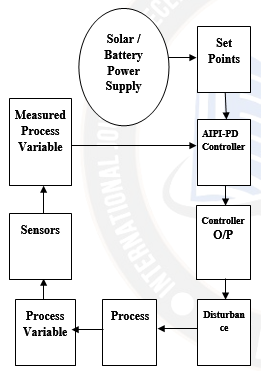Analysis of Unmanned Four-Wheeled Bot with AI Evaluation Feedback Linearization Method
Main Article Content
Abstract
In this research paperwork, thereis the design and implementation of aBot with the ability to work in four directions of movement forward, backward, left, and right using aself-governingstability system. The bot's resultingbe in command of objective is to follow a path at the required speed, while its primary control purpose is to maintain equilibrium whenever the balance position is unstable owing to a change in the center of gravity. We report our surveys into the concertevaluation of a highly linear four-wheeledmatchingmachine using a PID regulator and a PI-PD regulator. Here I have added advantages with the AI evaluation feedback linearization technique to detect and process with auto error time solutions. The key benefits include cogency in the actual application; switchdevice, enhanced performance, and capacity to overcome uncertainties. Simulated and experimental findings are used to compare and support a performance evaluation of the system. Numerous automatic systems for detecting traffic accidents have been developed by researchers. These techniques frequently make use of many applications such as smartphones, infrared sensors, and mobile applications.All of these techniques fall short when it comes to the instinctiverecognition of traffic accidents. The sifters used in smartphones may make it difficult to detect low-speed collisions. The suggested system does not specify the threshold distances at which an IR sensor will react. It is suggested to use a revolutionary method based on ultrasonic sensors.Using an ultrasonic sensor to identify accidents allows for the ability to do so not only in different street contexts but also in industrial settings, busy intersections, and weather circumstances like clouds, fog weather, rain, and heavy traffic.
Article Details
References
R. Fierro, F. Lewis, and A. Lowe, “Hybrid control for a class of underactuated mechanical systems,” IEEE Transactions on Systems, Man and Cybernetics, Part A: Systems and Humans, vol. 29, no. 6, pp. 649–4, Nov 1999.
K. Xu and X.-D. Duan, “Comparative study of control methods of a single-rotational inverted pendulum,” in Proceedings of the First International Conference on Machine Learning and Cybernetics, vol. 2, 2002, pp. 776–8.
F. Grasser, A. D’Arrigo, S. Colombi, and A. C. Rufer, “JOE: A mobile, inverted pendulum,” IEEE Transactions on Industrial Electronics, vol. 49, no. 1, pp. 107–14, 2002.
R. C. Ooi, “Balancing a two-wheeled autonomous bot,” Final Year Thesis, The University of Western Australia, School of Mechanical Engineering, 2003.
N. M. A. Ghani, F. Naim, and P. Y. Tan, “Two wheels balancing bot with line following capability,” World Academy of Science, Engineering and Technology, vol. 55, pp. 634–8, 2011.
G. M. T. Nguyen, H. N. Duong, and H. P. Ngyuen, “A PID backstepping controller for two-wheeled self-balancing bot,” in Proceedings for the 2010 IFOST, 2010.
K.-H. Su and Y.-Y. Chen, “Balance control for two-wheeled bot via neural-fuzzy technique,” in SICE Annual Conference 2010, Proceedings of, Aug. 2010, pp. 2838 –2842.
O. Ozen, E. Sariyildiz, H. Yu, K. Ogawa, K. Ohnishi, A. Sabanovic, "Practical PID controller tuning for motion control", Mechatronics (ICM) 2015 IEEE International Conference on, pp. 240-245, 2015.
Campari, Kannur. "SELF BALANCING ROBOT." (2015).
T. S. Cleatus, S. Hedge, P. Harshitha and S. Jaswanth, "Unmanned two-wheeled bot using feedback linearization," 2017 International Conference on Intelligent Computing and Control Systems (ICICCS), 2017, pp. 1059-1062, DOI: 10.1109/ICCONS.2017.8250629.
Juang, Hau-Shiue, and Kai-Yew Lurr. "Design and control of a two-wheel self-balancing bot using the Arduino microcontroller board. “Control and Automation (ICCA), 2013 10th IEEE International Conference onIEEE, 2013.
U. Khalil, A. Nasir, S. M. Khan, T. Javid, S. A. Raza and A. Siddiqui, "Automatic Road Accident Detection Using Ultrasonic Sensor," 2018 IEEE 21st International Multi-Topic Conference (INMIC), 2018, pp. 206-212, DOI: 10.1109/INMIC.2018.8595541.
NUSRAT TAN "Computation of Stabilizing PI-PD Controllers,"175, Springer (2009)
V. Praveena, A. R. Sankar, S. Jeyabalaji, and V. Srivatsan, “Efficient accident detection and rescue system using ABEONA algorithm,” International Journal of Emerging Trends and Technology in Computer Science, vol. 3, no. 5, pp. 222–225, 2014.
B. Fernandes, V. Gomes, J. Ferreira, and A. Oliveira, “Mobile application for automatic accident detection and multimodal alert,” in 81st Vehicular Technology Conference (VTC Spring),. IEEE, 2015, pp. 1–5.
U. Khalil, T. Javid, and A. Nasir, “Automatic Road accident detection techniques: A brief survey,” in International Symposium on Wireless Systems and Networks (ISWSN). IEEE, 2017, pp. 1–6.
Ultrasonic Distance Sensor, “How an ultrasonic distance sensor works,” Last accessed on 20 July 2018.
J. Walker, R. Resnick, and D. Halliday, Fundamentals of Physics. Wiley, 2008.
Sparkfun, “UltrasonicSensorHC-SR04,” Last accessed on 20 July 2018.
E. McCune, Practical digital wireless signals. Cambridge University Press, 2010.
Carullo A. and M. Parvis, “An ultrasonic sensor for distance measurement in automotive applications,” IEEE Sensors Journal, vol. 1, no. 2, p. 143, 2001.
World Health Organization, “Road Traffic Injuries,” Last accessed on 20 July 2018.
World Health Rankings, “Health Profile: Pakistan,” Last accessed on 20 July 2018.
A.M. Khan and A. Tehreem, “Causes of road accidents in Pakistan,” Journal of Asian Development Studies, vol. 1, no. 1, pp. 22–29, 2012.
J. White, C. Thompson, H. Turner, B. Dougherty, and D. C. Schmidt, “Wreckwatch: Automatic traffic accident detection and notification with smartphones,” Mobile Networks and Applications, vol. 16, no. 3, pp. 285–303, 2011.
S. K. Poornesh, T.V. Harsha, “Automatic vehicle accident detection and messaging system using GPS and GSM modems,” International Journal of Scientific & Engineering Research, vol. 4, pp. 1937-1940,2013
R. Mariappan, L. Manjunath, G. Ramachandran, M. Porkodi and T. Sheela, "Super Artificial Intelligence Medical Care Systems with IoT Wireless Sensor," 2022 IEEE International Conference on Distributed Computing and Electrical Circuits and Electronics (ICDCECE), Ballari, India, 2022, pp. 1-4, doi: 10.1109/ICDCECE53908.2022.9792895.

